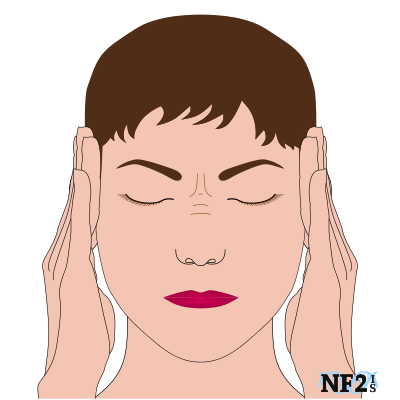Understanding NF2 >
Headaches
Last Updated: 03/4/25

Topics
- Types of Headaches
- Typical or Common Migraine
- Vestibular Migraine
- Ocular Migraine (Retinal Migraine)
Possible Risk of
Permanent Blindness - Tension Headaches
- Cluster Headaches
- Sinus Headaches
- Sources
Also See
MeditationBiofeedback/Neurofeedback
Types of Headaches
There are different types of headaches. The material included here is to explain headache types that often occur as a result of skull-based tumors. Skull based tumors often cause different forms of headaches depending on the location of the mass, and when an individual with a tumor faces situations that might trigger a headache in an individual without a tumor, the headaches are more troublesome.
Identification of the type of headache(s) an individual is experiencing is necessary to determine treatments for management. Some form of headaches includes; 1) typical or common migraines, 2) vestibular migraine, 3) ocular or retinal migraines, 4) tension headaches, 5) cluster headaches, and 6) sinus headaches.
1. Migraine - Typical or Common
Migraines are a recurring type of headache. They cause moderate to severe pain that is throbbing or pulsing. The pain is often on one side of your head. You may also have other symptoms, such as nausea and weakness. You may be sensitive to light and sound. [MedlinePlus]
2. Vestibular Migraine
Migraines are an incapacitating combination of neurological symptoms that can last anywhere from a few hours to several days and can severely interfere with a person's life. Some of the following usually characterize migraines: [WebMD]
- heavy or dull feeling of pounding, pulsating or throbbing in the head
- only one or both sides of head
- steady ache
- often accompanied by; nausea, vomiting, sensitivity to light or sound, or dizziness
(nausea from a migraine, will not be resolved with vomiting.)
2.1. Warning Symptoms (Auras)
Warning symptoms known as aura may occur before or with a headache. These can include:
- difficulty speaking
- hearing noises (tinnitus)
- pins and needles sensations in an arm or leg
- uncontrollable jerking or other movements
- vision loss
- visual phenomena, such as seeing various shapes, bright spots or flashes of light
- weakness or numbness in the face or one side of the body
Treatment
Medication Options: There are two ways to approach the treatment of a migraine headache with drugs; 1) Relieve the Symptoms during the attacks, or 2) Prevent the Attacks. Migraines options should be discussed with your doctor. Talk to your doctor about a prescription for either Imitrex (Sumatriptan) or Erenumab.
Relieve the Symptoms: Non-prescription medicines, over the counter (OTC) medicines do not always help. Talk to your doctor about possible prescription options to take as needed. It is important to know side effects of OTC's since many can relieve some of the migraine symptoms but result in other issues.
Reasons for Vestibular Migraine (Triggers)
Prevention of a Migraine: If an individual is prone to migraines, the best thing to do is determine what in their life might help increase chances of a Migraine,
Things that can trigger vestibular migraines include growth or change of tumor on brain cranial nerve 8, vestibular nerve and:
- Anxiety or Stress: For many people, treatments to relieve stress can also help reduce migraine occurrences.
- Lack of food or sleep
- Dehydration
- Antioxidants: berries, coffee, or chocolate
- Hormonal Changes (in women); Menstruation or Menopause
3. Ocular Migraine (Retinal Migraine)
An ocular migraine (retinal migraine) is a migraine that involves vision disturbances in one or both eyes and may be the result of compression in the skull behind the eyeballs, or papilledema. A common reason for papilledema is presence of a brain tumor.
These headaches are the typically the result of a serious condition and should be discussed with a doctor either a eye specialist neurologist as soon after the incident as possible. Left untreated the pressure can result in permanent types of loss of vision.
Symptoms Include:
- Flashes of light
- Zigzagging patterns
- Blind spots
- Shimmering spots or stars
Ocular Migraines can also include some of the same symptoms of a typical migraine, is an issue to see a doctor about since delay in management can result in permanent mlindness.
4. Tension Headaches
Tension headaches are your common, everyday headaches and can feel like there is a band being squeezed around your head, causing a dull ache on both sides. They're also sometimes associated with neck and shoulder stiffness. Tension headaches are either episodic in frequency, meaning they strike sporadically, or chronic, meaning they occur daily or almost daily.
5. Cluster Headaches
Cluster headaches are commonly recognized as one of the most painful types of headaches. Cluster headaches cause intense, excruciating pain on one side of the head, often around the eye, though sometimes affecting the nose and other areas of the face, too. Tears or a runny nose can be common. Pain comes on suddenly and can last anywhere from fifteen minutes to three hours. Attacks occur daily in clusters - hence the name - of weeks or months, and then go into remission for months to years.
6. Sinus Headaches
Sinus headaches are commonly the result of;
- a Sold or Sinusitis, which is an inflammation of the sinuses
- a Nasal Infection from bacteria
Sinusitis results in air-filled spaces behind your; forehead, nasal bones, cheeks, and eyes. - a Tumor is causing pressure that may be damaging to; 1) any part of the Sinuses, 2) Facial Nerve (CN7), or 3) Trigeminal Nerve (CN5).
Sinus headaches are characterized by deep and constant pressure-like pain in the cheekbones, forehead, or bridge of the nose. This pain usually intensifies with sudden head movement or straining and is usually accompanied by symptoms such as fever, runny nose, and clogged ears.
Sources
- Medline Plus "Migraine" (2020) https://medlineplus.gov/migraine.html
- "Excedrin." Headache Types. https://www.excedrin.com
- "Migraine Headache." Mayo Clinic. http://www.mayoclinic.org/diseases-conditions/migraine-headache/home/ovc-20202432
- "New Chronic Migraine Treatment Works for Those Failed by Other Drugs, Study Shows." Newsweek. (April 18, 2018) http://www.newsweek.com/migraines-headaches-drug-development-erenumab-890291
- "A 'Breakthrough' Injection Could Reduce Number of Migraines Patients Suffer by 50 Percent." American Academy of Neurology, News Week (April 18, 2018) https://www.thedailybeast.com/a-breakthrough-injection-could-reduce-migraines-by-50-percent
- "Novartis presents new analysis demonstrating AMG 334 (Erenumab) significantly reduced monthly migraine days in patients who failed previous preventive therapies." Novartis. (Sep 07, 201) https://www.novartis.com/news/media-releases/novartis-presents-new-analysis-demonstrating-amg-334-erenumab-significantly
- "Erenumab Reduces Migraine in Hard-to-Treat Patients." MedPage. (April 17, 2018) https://www.medpagetoday.com/meetingcoverage/aan/72398
-
"How to Spot 7 Types of Migraines"Prevention
https://www.prevention.com/health/types-migraines -
"1-2 caffeinated drinks not linked with higher risk of migraines; 3+ may trigger them" Science Daily (2019)
https://www.sciencedaily.com/releases/2019/08/190808091422.htm -
Randolph W. Evans, MD Practical Neurology "Migraine and the Presidency: Clinical Lessons from History?"
https://practicalneurology.com/articles/2011-nov-dec/migraine-and-the-presidency-clinical-lessons-from-history


 |Google Play
|Google Play